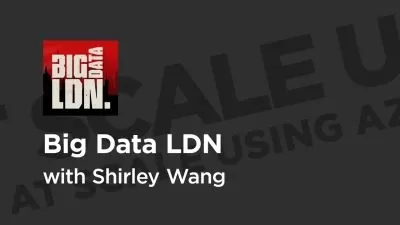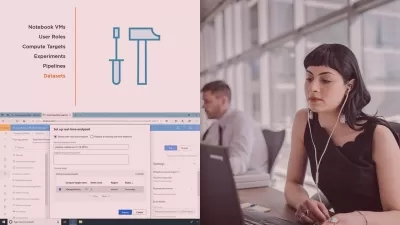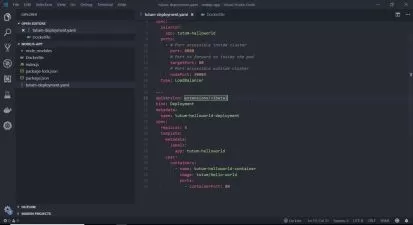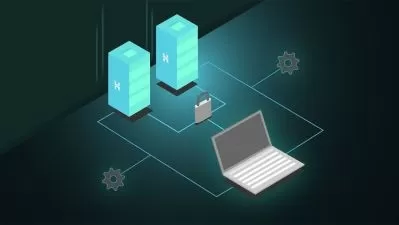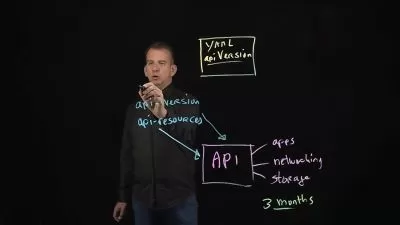Azure Kubernetes Service (AKS) Made Easy: Updated April 2023
Andrei Barbu | Microsoft employee working with AKS on a daily basis
14:33:27
Description
A Comprehensive and Practical Course: Containers, K8s, Networking, Security, Scaling, Storage, Monitoring, HA and others
What You'll Learn?
- How AKS works and its components
- Basic and advanced AKS features
- Integrations of AKS with other Azure services or third-party and open-source products
- How to manage, administer or deploy containerized applications in AKS
- How to monitor and troubleshoot applications and the AKS cluster itself
Who is this for?
More details
DescriptionIn today's fast-paced and dynamic business environment, containerization and orchestration are becoming increasingly important. Kubernetes has become the de facto standard for container orchestration and management, providing organizations with the flexibility and scalability needed to manage modern applications.
Microsoft Azure Kubernetes Service (AKS) is a fully managed Kubernetes service that eliminates the complexity of managing and scaling your Kubernetes infrastructure, enabling you to focus on building and deploying your applications. AKS offers benefits such as seamless integration with other Azure services, rapid deployment and scaling, automatic upgrades, built-in security and compliance, and much more.
This course is meant to make AKS easy to learn, understand, and to provide students with a comprehensive and practical experience with AKS.
The course start with an introduction about containers and Kubernetes, then we will cover topics such as creating and managing Kubernetes clusters, understand the components at Kubernetes and Azure level, configuring networking with respect to network plugins, Kubernetes services, SNAT, outbound types and types of AKS clusters in relation to control plane access, like public or private AKS clusters and the ones with VNET integration.
Security will be the next topics and we will start with a section about AKS-managed Active Directory integration, then we will look gain knowledge of identities, certificates, network policies, how to use secrets from the Azure Key Vault, about Azure policy, Microsoft Defender, AppArmor, and SecComp.
Scaling is important, so we will discover resource reservations, Horizontal Pod Autoscaler (HPA), Vertical Pod Autoscaler, Cluster Autoscaler (CAS), Virtual Nodes add-on, and KEDA.
The next section will be Storage, and you will learn how to use Azure Disk, including snapshot, resize, Azure File, and Azure Blob in AKS.
Then, we will discover the monitoring and troubleshooting chapter, where we will learn default available features as well as enabling Container Insights or managed Prometheus and Grafana.
Subsequent to this, we will learn about upgrades and related features like auto-upgrade or planned maintenance, then how to integrate our AKS cluster with the Azure Container Registry.
After this, we will focus on ingress controllers, like application gateway ingress controllers (AGIC) and nginx ingress controllers, and how to expose an application via HTTPS or how to use Let's Encrypt and Cert Manager.
Finally, we will focus on high availability, and you will learn about available tiers, availability zones, and how to obtain reliability while routing traffic between multiple AKS clusters.
By the end of this course, you will be equipped with the skills and knowledge to effectively deploy and manage Kubernetes clusters in AKS, and to leverage the benefits of AKS in the industry, including faster application development, improved scalability, and increased flexibility.
Who this course is for:
- Any beginner that just started with Azure Kubernetes Services (AKS)
- Cluster Administrators who are going to manage AKS clusters
- Developers who are planning to host applications in AKS
- Architects looking to implement AKS with other services
- Anyone who is looking to learn a new skill
In today's fast-paced and dynamic business environment, containerization and orchestration are becoming increasingly important. Kubernetes has become the de facto standard for container orchestration and management, providing organizations with the flexibility and scalability needed to manage modern applications.
Microsoft Azure Kubernetes Service (AKS) is a fully managed Kubernetes service that eliminates the complexity of managing and scaling your Kubernetes infrastructure, enabling you to focus on building and deploying your applications. AKS offers benefits such as seamless integration with other Azure services, rapid deployment and scaling, automatic upgrades, built-in security and compliance, and much more.
This course is meant to make AKS easy to learn, understand, and to provide students with a comprehensive and practical experience with AKS.
The course start with an introduction about containers and Kubernetes, then we will cover topics such as creating and managing Kubernetes clusters, understand the components at Kubernetes and Azure level, configuring networking with respect to network plugins, Kubernetes services, SNAT, outbound types and types of AKS clusters in relation to control plane access, like public or private AKS clusters and the ones with VNET integration.
Security will be the next topics and we will start with a section about AKS-managed Active Directory integration, then we will look gain knowledge of identities, certificates, network policies, how to use secrets from the Azure Key Vault, about Azure policy, Microsoft Defender, AppArmor, and SecComp.
Scaling is important, so we will discover resource reservations, Horizontal Pod Autoscaler (HPA), Vertical Pod Autoscaler, Cluster Autoscaler (CAS), Virtual Nodes add-on, and KEDA.
The next section will be Storage, and you will learn how to use Azure Disk, including snapshot, resize, Azure File, and Azure Blob in AKS.
Then, we will discover the monitoring and troubleshooting chapter, where we will learn default available features as well as enabling Container Insights or managed Prometheus and Grafana.
Subsequent to this, we will learn about upgrades and related features like auto-upgrade or planned maintenance, then how to integrate our AKS cluster with the Azure Container Registry.
After this, we will focus on ingress controllers, like application gateway ingress controllers (AGIC) and nginx ingress controllers, and how to expose an application via HTTPS or how to use Let's Encrypt and Cert Manager.
Finally, we will focus on high availability, and you will learn about available tiers, availability zones, and how to obtain reliability while routing traffic between multiple AKS clusters.
By the end of this course, you will be equipped with the skills and knowledge to effectively deploy and manage Kubernetes clusters in AKS, and to leverage the benefits of AKS in the industry, including faster application development, improved scalability, and increased flexibility.
Who this course is for:
- Any beginner that just started with Azure Kubernetes Services (AKS)
- Cluster Administrators who are going to manage AKS clusters
- Developers who are planning to host applications in AKS
- Architects looking to implement AKS with other services
- Anyone who is looking to learn a new skill
User Reviews
Rating
Andrei Barbu | Microsoft employee working with AKS on a daily basis
Instructor's Courses
Udemy
View courses Udemy- language english
- Training sessions 149
- duration 14:33:27
- Release Date 2023/04/25








